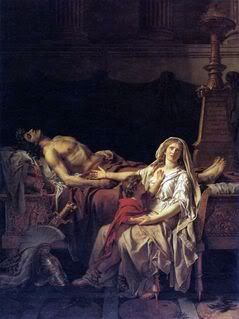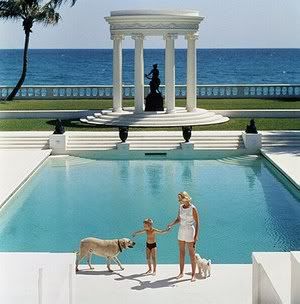
Have you ever wondered if the colour of your perfume is not a haphazard choice? Have you asked yourselves if you would love it equally if it were a different hue? Or more importantly if the people involved in creating it have actually exerted any brainstorming about this?
A funny incident happened a while ago and made me consider the issue from another angle than the mere personal.
On a fine lunch hour shopping spree I passed from that shop that was inspired by Moses' wife and rhymes with catastrophe in Greek (which is what my significant other always mutters when he sees a bag with the white-on-black logo of it). I am referring of course to Sephora.
As I was browsing, nodding to myself "already tested", "already tested", "already tested", I come close to a couple at the Lauder shelves. Casually dressed but well groomed (the european groomed casual chic), around 30 both.
The girl, a dark haired one, rather pretty, grabs the tester for Knowing and ooohs and aaahs saying "Oh, this is my favourite perfume in the world, wore it so much". (I am thinking she wanted the guy to take the hint and buy it for her- and she was not the mercenary type at all). The guy seems uninterested and browses beside her, going "uh huh". She then picks up Cinnabar, as they have the older Lauders all grouped together. "This is nice too" she comments smelling the bottle.(I agree) She gives it to the guy, who says they are both rather heavy, vetoing the decision. She is even motioning to pick up the Youth Dew, when he intervenes and says : "Imagine how heavy that one must be; it's almost black!!" She never finished the motion to pick it up and sniff the bottle, as she didn't do it with Aliage either (which is also quite dark). And immediately he goes on and picks the nearby Alien (Sephora places them alphabetically and Mugler is after Lauder). "Now this is lighter, better" he quips. (the "light" thing merits its own discussion in another post) She made a face. I just about wanted to smack him at that point! Both because he denied her what she obviously liked and because he showed his prejudices about perfume picking. I didn't follow them to see what they bought in the end. I didn't have the luxury of time. Maybe they didn't buy anything. If they did however it was not what she wanted, she seemed crestfallen....
I don't see these two making it to the aisle and that doesn't refer to the shopping kind.
The little story has a moral though. People judge with their eyes as much as with their noses.
There is another great story that has been recounted to me by J, known as Teacake, a sweet Australian-based lady. She mentioned that someone young (a teenager actually) who was a friend of her daughter had proclaimed upon viewing her collection that "yellow/golden juices don't smell nice, only pink and blues do". That comment has been a mini-epiphany for me. Seriously: it made me realise that indeed the colour of the jus really denotes the target market as well as the olfactory family in most cases: fruity florals and "fresh" scents which were all the rage with the young some nanoseconds ago are indeed pink or blue!
I don't think this is an accident. I believe it has to do with the mentality that yellow jus is older, classic perfumes that are associated with natural ingredients (no naturals are coloured pink or blue, except chamomille of course and they don't use it in most commercial perfumery because of that unstable blueish tint that might ruin the general effect).
If one stops and thinks about it most of the classics are pale golden or light ambery: Shalimar, Femme, Mitsouko, Joy, Chanel #5, Bois des iles, L'heure bleu. They all vibrate at some variation of wee colour. There are a few notable exceptions like Chanel #19 or the afore mentioned Youth Dew, but still no pink or blue or even purple coloured perfume existed till quite recently. Certain natural ingredients do have a deep colour: Peru Balsam is molasses dark; natural jasmine turns almost orange with the passing of time, sometimes alarming us into thinking that a perfume containing it has turned.
Pink and blue juice on the other hand usually has a highly synthetic construction that guarantees the stability of colour and the unnatural hue of the finished product.
Personally, I have a deep seated aversion to the colour blue in fragrances, although I do appreciate it in other permutations (the sea, glassware and jewels come to mind). I think it shows an insurmountable lack of imagination on behalf of the person who opts for it; especially if it's a man, I'm afraid. It's such an easy, safe choice! What's your favourite colour? 9 out of 10 men reply blue, if asked out of the blue about it (am I being punny?). I don't hear fuschia (too gay), chesnut(too difficult; do they even know it's a shade?), vermillon (it sounds like a french recipe for something involving snails or frog's legs) or even black (the odd rocker/goth/outcast/mysterious Lothario picks that one up out of the 10.....thank God fot that)
In perfume terms it usually denotes an overload of the dreaded fakeness that is the "marine" note. Yeah.....marine for people born and raised and living all their lives in the Chezh Republic(a landlocked country); having no passport on top of that. I am categorically adamant that the sea does not smell like any of the marine fragrances out there I have ever smelled. I do keep hoping some day they will catch the elusive trail. I live in hope.
Anyway, younger folks tend to associate the hip and new with those pastel hues, dismissing the rest as "old ladies' perfume". In their desire to mark their territory and draw the line, maping their own identity, revolting from what their parents wear, they go for the pink and blue, with the odd inclusion of purple for those who like a smidgeon of mystery (or so they imagine).
So companies churn out perfumes in those colours. It's all marketing, I'm afraid.
Pic was sent to me via mail uncredited, probably courtesy of an advertising campaign (MAC maybe?)
Not sure, but great photo nonetheless.
.jpg)








